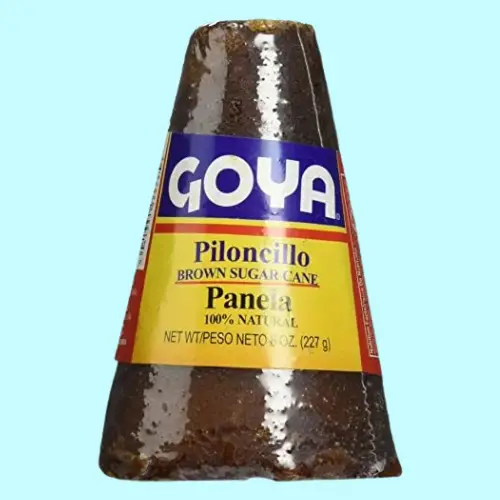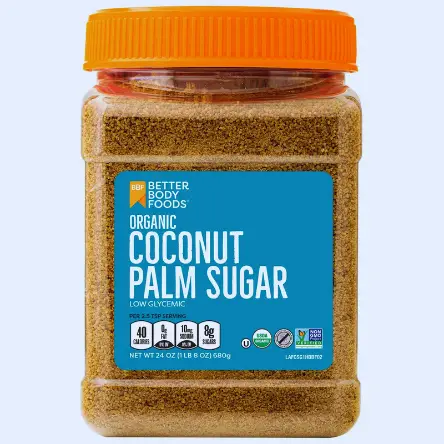It is also known as coconut sugar, jaggery, or gur (made from palm tree sap). It is a dark coarse sugar extract from various palm trees or sugarcane juice favored in India. The soft type is spreadable, while the solid cake is crushed to use as a topping or a confectionery ingredient. This sweetener adds complex, wine-like flavor and aroma to many dishes.
Palm sugar is any sweetener made from any type of palm tree and can be regularly found in dishes throughout Asia. It is pressed into small discs and is not typically found in a free-flowing form like granulated sugar. Palm sugar in granular form has recently come onto the market; this is easier to measure accurately and is a good choice for baking. Coconut sugar is gaining popularity with health-conscious cooks.
If eating Thai or Indian cuisines (curries, sauces, and desserts), the sugar used in cooking and baking will most likely be palm sugar. It is a natural sweetener in health food stores and supermarkets within their international sections.
Contents
Top 5 Palm Sugar Substitutes Ideas
[1] Piloncillo

Use piloncillo. Piloncillo is also known as panela, panocha and rapadura. Mexican or South American unrefined cane sugar is shaped into a rigid truncated cone (piloncillo) or a block (panela or rapadura). Sometimes available in lighter (Blanco or claro) or darker (Oscuro or Prieto), the flavor and color are like molasses brown sugar.
Piloncillo is a type of unrefined, cone-shaped sugar that’s used in Mexican cooking. It can be found in Mexican markets and online, but it’s also possible to make your own at home if you’re feeling ambitious!
You can use piloncillo in place of white sugar in recipes, or you can grind it up and use it as an ingredient in dishes like mole sauce. It has a richer taste than white sugar, and goes especially well with chocolate. The flavor is similar to brown sugar, but deeper and more complex.
= 1 cup piloncillo can be used to replace 1 cup palm sugar.
[2] Black Sugar
Black sugar comes in a solid block and has a strong molasses flavor. Black sugar is a Japanese unrefined brown sugar pressed into a firm yet moist rectangular block with an intense molasses flavor.
Black sugar, also known as panela in Spanish, is a form of unrefined sugar that is made from sugarcane. It’s a little bit different from regular white sugar because it’s typically processed at a lower temperature and has a darker color.
It’s very popular among people who live in Latin America, but it’s becoming more common in other parts of the world as well. There are many different uses for black sugar—it can be used as a sweetener in recipes like cakes and desserts, or you can simply use it to add flavor to your favorite dishes.
= 1 cup black sugar is a replacement for 1 cup palm sugar.
[3] Brown Sugar
Use dark brown sugar instead of light brown sugar for a deeper molasses flavor for cooking, baking, spice rubs, and marinades. To measure accurately, always pack the sugar firmly into a measuring cup.
Brown sugar is just white sugar with molasses added.
Molasses is a by-product of the process of refining white sugar. When you refine white sugar, you get white crystals that are 99.9% pure sucrose and 0.1% water. To make brown sugar, you add back in some of the molasses that was removed during the refining process.
Brown sugar is about 95% sucrose, with the remaining 5% being made up of various other sugars (including maltose and glucose).
= 1 cup dark brown sugar + 2 teaspoon molasses as a substitute for palm sugar.
Light brown sugar is made by mixing granulated (white) sugar with molasses. Generally, the lighter the brown color, the less molasses is added. To keep the sugar soft after opening a package, place a strip of orange zest, about 3 inches by 1 inch, in the bag. Seal tightly and store inside a resealable plastic bag.
= 1 cup light brown sugar + 5 teaspoons molasses will replace 1 cup palm sugar.

[4] Granulated (White) Sugar
Granulated sugar is the most common type of sugar you’ll find in the grocery store. It comes in a variety of sizes, but it’s typically sold in 1-pound bags or 5-pound bags.
Granulated sugar is made by grinding up sugar cane or sugar beets into smaller pieces that can then be measured more easily and mixed with other ingredients. The size of the granules varies depending on how long they’ve been ground down and how many times they’ve been ground down—the longer it takes to make granulated sugar, the smaller its granules will be.
= 1 cup granulated sugar + 4 to 5 tablespoons molasses is exchanged for 1 cup palm sugar.
[5] Golden Monkfruit
To avoid adding carbs to a dish, try substituting a little golden monkfruit. Monkfruit is much sweeter than sugar; therefore, you will want to use less to start and add more to taste.
Golden monkfruit is a relative of the much more well-known stevia plant. It’s been used for centuries as a sweetener in Asia, and recently, it’s been making its way into our favorite American foods.
It has been shown to have zero calories—making it a great alternative for those who are looking to cut down on their sugar intake. In addition, it’s got some extra antioxidant properties that can help your body fight off free radicals and protect against disease.
= 1/2 to 3/4 cup of Monkfruit is an equivalent exchange for 1 cup palm sugar.
How Palm Sugar is Made
The sugar is made from various palm trees, including palmyra, date, toddy, nipa, sugar, and coconut palms. The sap is collected from the palm flowers and boiled until it reduces to crystals. No chemicals are used in the process, so the sugar is unrefined. It is a labor-intensive process, much like that of making maple syrup. Due to the time involved, palm sugar is more expensive.
Sugarcane can also be boiled until it becomes solid. It is formed into blocks or cakes and can be soft and crumbly to rock hard. To use it requires shaving or grating.
Palm sugar can be found in a paste-like form, which is softer and generally sold in plastic tubs. The processing of palm sugar will create a golden color (in Thailand) to almost black, as with Indonesian palm sugar.

FAQ
What is the difference between palm sugar and regular sugar?
Granulated (white) sugar comes from sugar cane or sugar beets. Palm sugar is made from various palm trees, including palmyra, date, toddy, nipa, sugar, and coconut palms. The sap is collected from the palm flowers and boiled until it reduces to crystals.
Which is healthier – palm sugar or cane sugar?
Palm sugar measures lower on the glycemic index than cane sugar, so it is healthier from that perspective.